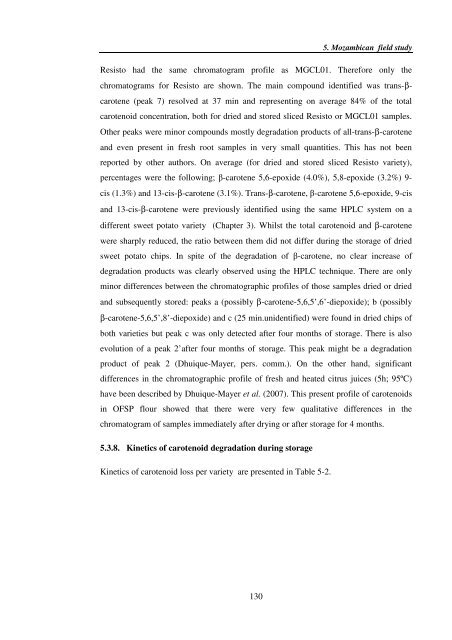Investigating carotenoid loss after drying and storage of
Investigating carotenoid loss after drying and storage of
Investigating carotenoid loss after drying and storage of
You also want an ePaper? Increase the reach of your titles
YUMPU automatically turns print PDFs into web optimized ePapers that Google loves.
130<br />
5. Mozambican field study<br />
Resisto had the same chromatogram pr<strong>of</strong>ile as MGCL01. Therefore only the<br />
chromatograms for Resisto are shown. The main compound identified was trans-β-<br />
carotene (peak 7) resolved at 37 min <strong>and</strong> representing on average 84% <strong>of</strong> the total<br />
<strong>carotenoid</strong> concentration, both for dried <strong>and</strong> stored sliced Resisto or MGCL01 samples.<br />
Other peaks were minor compounds mostly degradation products <strong>of</strong> all-trans-β-carotene<br />
<strong>and</strong> even present in fresh root samples in very small quantities. This has not been<br />
reported by other authors. On average (for dried <strong>and</strong> stored sliced Resisto variety),<br />
percentages were the following; #-carotene 5,6-epoxide (4.0%), 5,8-epoxide (3.2%) 9-<br />
cis (1.3%) <strong>and</strong> 13-cis-β-carotene (3.1%). Trans-β-carotene, #-carotene 5,6-epoxide, 9-cis<br />
<strong>and</strong> 13-cis-β-carotene were previously identified using the same HPLC system on a<br />
different sweet potato variety (Chapter 3). Whilst the total <strong>carotenoid</strong> <strong>and</strong> β-carotene<br />
were sharply reduced, the ratio between them did not differ during the <strong>storage</strong> <strong>of</strong> dried<br />
sweet potato chips. In spite <strong>of</strong> the degradation <strong>of</strong> #-carotene, no clear increase <strong>of</strong><br />
degradation products was clearly observed using the HPLC technique. There are only<br />
minor differences between the chromatographic pr<strong>of</strong>iles <strong>of</strong> those samples dried or dried<br />
<strong>and</strong> subsequently stored: peaks a (possibly β-carotene-5,6,5’,6’-diepoxide); b (possibly<br />
β-carotene-5,6,5’,8’-diepoxide) <strong>and</strong> c (25 min.unidentified) were found in dried chips <strong>of</strong><br />
both varieties but peak c was only detected <strong>after</strong> four months <strong>of</strong> <strong>storage</strong>. There is also<br />
evolution <strong>of</strong> a peak 2’<strong>after</strong> four months <strong>of</strong> <strong>storage</strong>. This peak might be a degradation<br />
product <strong>of</strong> peak 2 (Dhuique-Mayer, pers. comm.). On the other h<strong>and</strong>, significant<br />
differences in the chromatographic pr<strong>of</strong>ile <strong>of</strong> fresh <strong>and</strong> heated citrus juices (5h; 95ºC)<br />
have been described by Dhuique-Mayer et al. (2007). This present pr<strong>of</strong>ile <strong>of</strong> <strong>carotenoid</strong>s<br />
in OFSP flour showed that there were very few qualitative differences in the<br />
chromatogram <strong>of</strong> samples immediately <strong>after</strong> <strong>drying</strong> or <strong>after</strong> <strong>storage</strong> for 4 months.<br />
5.3.8. Kinetics <strong>of</strong> <strong>carotenoid</strong> degradation during <strong>storage</strong><br />
Kinetics <strong>of</strong> <strong>carotenoid</strong> <strong>loss</strong> per variety are presented in Table 5-2.






